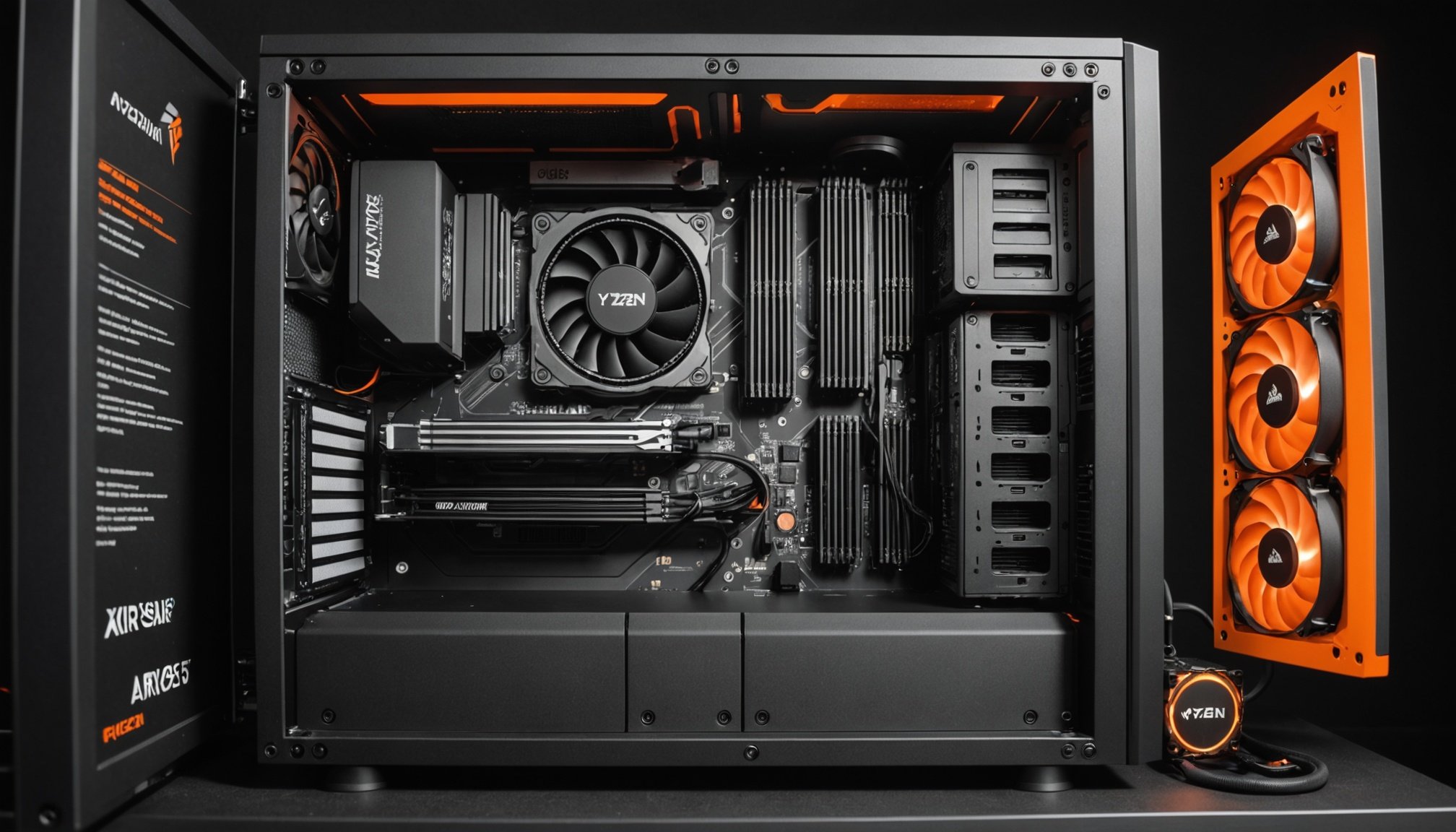Understanding Your Hardware
Choosing the right hardware can significantly impact your computing experience. For instance, the Ryzen 9 5900X processor is a powerhouse with 12 cores and 24 threads, offering exceptional multitasking capabilities. Its boost clock speed can reach up to 4.8 GHz, making it ideal for tasks such as video editing and gaming. AMD’s Zen 3 architecture enhances performance and power efficiency, a vital element for demanding applications.
When it comes to graphics, the RTX 3090 is unparalleled. Known for its robust performance, it features 24 GB of GDDR6X memory, which ensures smooth gameplay and seamless rendering. The inclusion of real-time ray tracing and AI-enhanced graphics provides an immersive gaming experience. Gamers will benefit from the card’s support for NVIDIA’s DLSS technology, enhancing image quality without sacrificing performance.
Have you seen this : Ultimate guide to strengthening small business security: how to install and configure a firewall on your pfsense system
Finally, housing these components in a well-designed case like the Corsair 5000D Airflow is crucial. Its optimal airflow design aids in maintaining lower temperatures, thus preserving the lifespan of your components. It offers ample space for cable management and additional cooling solutions, such as liquid cooling systems, ensuring that your high-performance equipment runs efficiently and reliably, even under heavy loads.
Optimizing Cooling Solutions
Selecting the right cooling solutions is vital for optimal performance of the Corsair 5000D. Effective airflow management ensures components stay within safe temperature ranges. Proper intake and exhaust fan placement are fundamental for improving thermal performance. It’s advisable to position equal numbers of intake and exhaust fans to create a balanced airflow, reducing hot air pockets within the case.
Additional reading : Comprehensive blueprint for crafting a high-performance media server using nvidia shield tv and external storage options
When considering cooling solutions, the choice between air coolers and liquid coolers depends on your performance needs. Air coolers are often more budget-friendly and easier to install, while liquid coolers offer superior heat dissipation, especially for overclocked systems. For the Corsair 5000D, both options can work seamlessly, provided airflow pathways aren’t obstructed by other components.
Another crucial aspect under thermal performance is the application of thermal paste. Proper application ensures effective heat transfer from the CPU to the cooler. Monitor temperatures regularly to detect any anomalies early on and ensure long-term system stability.
In summary, combining strategic airflow management with the best-suited cooling solution and careful application of thermal paste will significantly enhance the performance of your Corsair 5000D, allowing you to maintain optimal temperatures effortlessly.
Overclocking Techniques
When embarking on an overclocking journey, achieving optimal performance requires precise performance tuning. Here’s a step-by-step guide for the Ryzen 9 5900X, which is a popular choice for such enthusiasts.
-
Preparation: Update your BIOS and ensure you have a robust cooling system, as overclocking increases heat production.
-
BIOS Setup: Access BIOS by pressing the correct key upon booting. Navigate to the CPU settings and start by increasing the clock multiplier to enhance processor speed.
-
Voltage Adjustment: Gradually increase the CPU core voltage to stabilize the system. Be cautious, as excessive voltage can cause thermal throttling or damage.
-
Stress Testing: Utilize benchmarking tools to assess the stability of the system. This ensures that the system remains functional under conventional workloads.
For the RTX 3090 GPU, similar rules apply. Start by using software like MSI Afterburner to incrementally increase the core clock speeds. Monitor temperature and performance metrics through benchmarking to ensure a balance between speed and sustainability.
Here are a few benchmarks to gauge the performance improvements from overclocking:
- 3DMark: Widely recognized for its comprehensive testing of graphics capabilities.
- Cinebench: Focused on CPU rendering performance, useful for measuring the overclocked Ryzen’s capability.
These tests highlight the gains and help troubleshoot potential instabilities.
Fine-tuning BIOS Settings
Fine-tuning BIOS settings can significantly boost the performance of a system equipped with Ryzen 9 and RTX 3090. Understanding and configuring memory configuration is vital, especially for gaming enthusiasts. Key BIOS settings that can enhance performance optimization include adjusting memory timings and selecting the appropriate profiles. These adjustments ensure that the CPU and GPU handle high workload demands efficiently, reducing bottlenecks and improving overall responsiveness.
Memory timings and profiles are crucial as they dictate how quickly and efficiently the RAM communicates with other components. Lower latency and tighter timings provide a smoother gaming experience, reducing lag and enhancing frame rates. It’s important to ensure that your system’s memory is fully synchronised with the CPU, maximising its capabilities.
When it comes to voltage settings, maintaining safe voltage is critical for sustained performance and hardware longevity. Overvolting can lead to increased temperatures and potential damage. Therefore, it’s essential to find a balance that allows for optimal performance without compromising stability or component lifespan. By carefully adjusting these BIOS settings, users can experience the full potential of their hardware, ensuring that their system runs smoothly and efficiently under various gaming scenarios.
Component Compatibility
When constructing a gaming setup featuring a powerful Ryzen 9 processor and RTX 3090 graphics card, ensuring component compatibility is crucial. The synergy between these components forms the backbone of performance, making it imperative to select compatible parts. For RAM, opt for at least 32GB of high-frequency DDR4 to complement this setup, as it provides the bandwidth necessary for smooth multitasking and demanding gaming environments.
Storage is another pivotal element to consider. A combination of NVMe SSDs with generous capacity can significantly enhance loading times and overall responsiveness, elevating your gaming setup to optimal efficiency.
Upgrade Considerations
Future-proofing your gaming rig involves more than just purchasing the latest components. As technology evolves, evaluating potential upgrades such as additional RAM slots or PCIe 4.0 support for newer GPUs can be advantageous. This proactive approach ensures that your gaming setup remains adaptable and relevant to upcoming advancements.
In summary, achieving component compatibility maximizes performance and allows for seamless future upgrades. The attention to detail in component compatibility can facilitate a more enjoyable and enduring gaming setup experience. Familiarising oneself with these considerations empowers gamers to make informed decisions, securing both current performance and future potential.
Troubleshooting Common Issues
Understanding and diagnosing performance issues can be daunting, but pinpointing the root cause is essential. Troubleshooting can address common problems like thermal throttling, which often leads to unexpected slowdowns. When a device experiences thermal throttling, it reduces performance to lower temperatures. To resolve this, ensure your cooling system is functioning optimally and consider using additional cooling pads if needed.
Monitoring performance is crucial. Several tools and software can assist in checking system health. Tools such as HWMonitor or CPU-Z are excellent for providing real-time data on temperature and system performance. They allow users to see if their device is operating under undue stress and make adjustments as necessary.
Stability is another aspect often impacted by performance issues. Ensure all drivers and software are up to date to avoid conflicts that may cause crash or freeze scenarios. Regular maintenance checks can prevent long-standing issues in systems experiencing instability.
In scenarios like these, precision in identifying the cause of an issue is paramount. Solutions should always match the specifics of the hardware and software configuration in question to prevent further complications.










